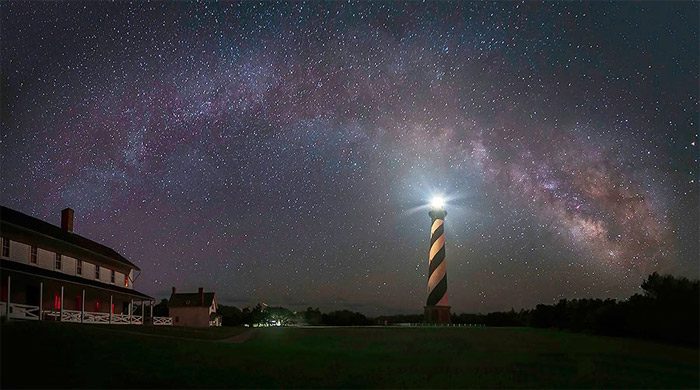
Making the most of what we have is an admirable characteristic of those of us living on Hatteras Island. And this fall has confirmed that our resiliency and the many resources of the Island continue to support us in difficult times. One of our major resources is the National Park Service. As we all saw, the success of the 1st Cape Hatteras Surf Fishing Heritage Celebration in November owed much to the cooperation between the Park Service and local retailers and non-profit organizations. So as we enter the winter months, let’s see what other local resources are available to us on our own and in cooperation with the National Park Service.
Those of us who commute from the Piedmont to the Outer Banks are immediately aware of the soothing darkness that envelops us when we come back to Hatteras Island. An evening stroll on the beach or rocking chair on an open deck makes us aware of the night sky that is literally filled with stars and easily recognized constellations, especially the dramatic Milky Way. The night sky is more than a beautiful canvas to enjoy. It is also part of a complex eco system that supports both natural and cultural resources. We all know that darkness is essential to the migration of our sea turtle hatchlings from their nests to the sea, and many local volunteers wait patiently in the darkness to help herd the little critters in the right direction. In our neighborhood, the sound of the owl is a joyous accompaniment to the night as is the scuttling of small woodland creatures.
That this resource is valued beyond our shores is noted in the International Dark Sky Places Program (IDSP), founded in 2001. It encourages communities and parks (like our Cape Hatteras National Seashore) to preserve and protect and dark sites through public education. Our local Interpretation Park Ranger, Steven Torpy, quotes, “Half the Park is After Dark,” and boasts that Cape Hatteras has impressive night skies that are easily accessible to major cities like Norfolk, VA, Washington, DC and, of course the burgeoning Research Triangle Park communities of Raleigh, Durham and Chapel Hill. Torpy reminds us that the grounds of the park remain open at night. He suggests that in the winter we can drive on the beach and also make use of the parking lots for Off-Road Vehicle Ramps 43 and 44 for access to the beach. In the summer, of course, Torpy offers a Dark Skies Over Hatteras program from Memorial Day through August 27. He describes it as a 60-minute presentation about stars and planets and how humans have engaged with the night skies for centuries.
To do their part to keep the night skies dark, the Park is retrofitting outdoor lights within park boundary to protect the dark sky resources. “By taking these measures,” says Torpy, “America’s first National Seashore is working to become an International Dark Sky Park.”
So follow Steven Torpy’s advice and go outdoors, turn off your flashlights and look up. He reminds us that, “Eighty percent of the US population can’t see the Milky Way because of light pollution.” But we can here on Hatteras Island. Aren’t we lucky!!
